Alligator-human Hybrids
Hybrids out of History
EUGENE M. MCCARTHY, PHD GENETICS, ΦΒΚ
|
Above the waist it was semi-anthropomorphic; though its chest, where the dog’s rending paws still rested watchfully, had the leathery, reticulated hide of a crocodile or alligator. The back was piebald with yellow and black, and dimly suggested the squamous covering of certain snakes. Below the waist, though, it was the worst; for here all human resemblance left off and sheer phantasy began.
—H. P. Lovecraft, The Dunwich Horror
|
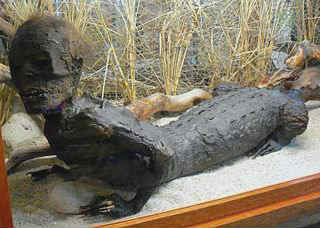 Jake the Alligator Man, an alleged half-man, half-alligator mummy on display at Marsh’s Free Museum in Long Beach, Washington. Image: Wikimedia. A much clearer picture of Jake, which cannot be shown here due to copyright restrictions, can be accessed on Flicker.
Jake the Alligator Man, an alleged half-man, half-alligator mummy on display at Marsh’s Free Museum in Long Beach, Washington. Image: Wikimedia. A much clearer picture of Jake, which cannot be shown here due to copyright restrictions, can be accessed on Flicker.
The actual occurrence of alligator-human hybrids was alleged in numerous 19th-century news reports, and such individuals were even the subject of articles in medical journals. However, reports about this cross all seem to lack the sort of specifics characteristic of honesty. In particular, no identifiable eyewitnesses are named and no exact addresses given. And the cross alleged is far more disparate than what most people would deem possible. Moreover the single available specimen has not been subjected to DNA analysis. So there seems to be very little to suggest that reports of this kind are anything more than hoaxes.
But more interesting is the existence of what just might be a specimen of such a hybrid, Jake the Alligator-Man, a mummified curio in the collection of Marsh’s Free Museum in Long Beach Washington. They keep Jake in a glass case there, and photos show him with the head and torso of a human being, but the lower body and tail of an alligator (see image right). As can be seen in this photo his lower torso, tail and hind legs are exactly like those of an alligator. Verbal descriptions his teeth are sharpened points. And as can be seen in the pictures, his hands are withered and claw-like. To my knowledge, no scientist has ever subjected Jake to molecular genetic analysis.
The founder of the museum, Wellington Marsh, Sr. bought Jake for $750 from an antique dealer in 1967. According to an online inflation calculator $750 would be equivalent to $5,470.13 in 2017. So it seems, paying that much money, Marsh must have thought he was getting the more than a taxidermist’s fake. The reference to an antique dealer suggests Jake is old. But how old? No one seems to know.
Unfortunately, just from the way Jake looks, it's easy enough to imagine a hoaxer taking the upper half of a real Egyptian mummy (there are literally millions of them available) and attaching it to the backend of an alligator. I could do the job myself. Look at this photo. It looks human down to the waist. All you'd have to do is plug the human torso into the alligator backend and voila!
Since Jake, the only available specimen of human-alligator hybrid, could easily have been faked and has never been genetically tested, this cross is poorly documented indeed. There are certain other, equally distant crosses that are far better substantiated, for example, chicken x human.
The glaring problem with most reports about human-alligator hybrids, beyond the large disparity between the proposed parents, is that there is a lot of hearsay, that is, the reports talk about what other people have seen in other places, and provide few specifics. A reliable report about any type of hybrid cross, should at a minimum specifically identify the author of the report and any other witnesses, and state exactly where the hybrid(s) can be found. Without such information, especially in a wide cross like alligator-human, a report becomes dubious indeed.
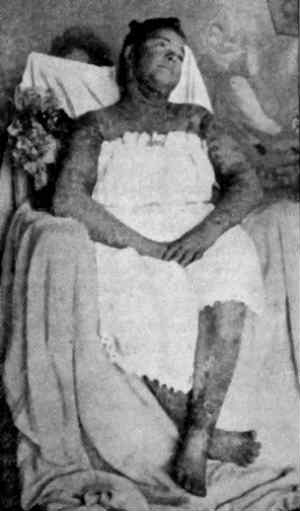 Betty the Alligator Girl (Source: Medical Summary, 1915, vol. 37, p. 293).
Betty the Alligator Girl (Source: Medical Summary, 1915, vol. 37, p. 293).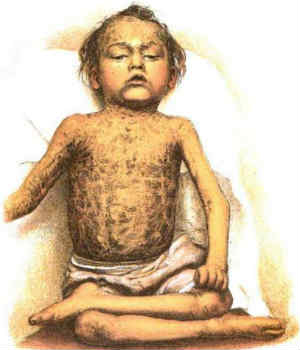 The Alligator Boy (as shown in the Journal of Cutaneous and Venereal Diseases, 1884, p. 97).
The Alligator Boy (as shown in the Journal of Cutaneous and Venereal Diseases, 1884, p. 97).
One report that goes beyond hearsay, and actually does give first-hand descriptions is that of Betty the Alligator Girl, shown at right (see: Medical Summary, 1915, vol. 37, p. 293). But in her case the symptoms of alligator heritage are not nearly so marked as in the second-hand accounts quoted below. In Betty’s case, there is no long alligator tail, no love of water or long basks in the sun. Her similarity to crocodilians seems to have been limited to the scaly skin condition known as ichthyosis, and a certain degree of mental deficiency. Ichthyosis is really a catchall term for a variety of skin disorders characterized by dry, thickened, scaly skin.
Another report from a medical journal, The Alligator Boy — A Case of Ichthyosis (Fox 1884, p. 97) discusses an individual, that from the description given, seems more like Jake than Betty, but the accompanying picture of the child (see image right) seems to document nothing beyond a severe skin condition. However, the physician’s verbal account reads:
At birth the child weighed four and one-half pounds and presented an ichthyotic condition which has since increased in severity. When about a year old, the frontal epidermis split vertically in the center of the forehead and was cast off in two lateral pieces.The hands, at this time, "looked like those of a ninety-year-old man." ... The muscles of the lower extremities were not at all developed, and he was scarcely able to stand alone. By means of his arms, he would creep across the floor quite readily, and, according to the fathers statement, could not only swim like his namesake, but had an uncontrollable desire to get into the water whenever opportunity offered. He had a good appetite and was especially fond of fish, oysters, and the whites of eggs. He liked fruit, but ate no meat, and I was assured that his bowels rarely moved oftener than once in two weeks.
The eruption, contrary to the rule in ichthyosis, was most marked upon the trunk, the epidermis being broken, by the movements of the body, into polygonal horny plates of varying size and of a dirty yellowish hue. In the intervening fissures, the pinkish color of the deeper skin was apparent. The scalp and forehead were also affected in a marked degree. The rest f the face was free from scales, save a slight mealy condition around the nose and mouth, and the cheeks were as smooth as soft as those of any child. The arms were but slightly affected, and the forearms, especially upon the extensor aspect, were almost natural in appearance. The legs also were almost free from scales. The parents stated that in winter the skin upon the trunk was smooth, though horny in character. In the spring, this horny integument was wont to crack and present the characteristic “alligator” appearance, while the hair of the head was almost entirely shed. In the summer, the scales would gradually lessen and the skin become much softer, though by no means normal.
This boy was born in Montreal, in May, 1879, and Dr. F. Kennedy, who officiated at his debut, has kindly furnished me with the following information. The mother was a primipara, and claimed that it was impossible for her to have been more than eight months pregnant at the birth of the child. At four and one-half months (according to the statement to me), she was frightened at the sight of an alligator, and, a few weeks later, by seeing a dog in a fit. A tedious and irregular labor was followed by a natural delivery. At birth the child presented a most extraordinary appearance. The skin was thickly covered with vernix caseosa, and, when washed, the surface was a smooth as if polished, and of a deep red color. In fact, the surface had the appearance of being thickly varnished. There were very few fissures noticeable, and so strong muscles in its efforts to cry or suck. Its limbs were also restricted in their movements. After a few days, fissures occurred more especially along the facial lines. On the forehead were two large scales separated along the median line. On the eyelids, cheeks, and around the mouth, armor-like scales were formed. On the back the scales were very thick. There was no healthy skin, as the whole surface was more or less covered with scales. The skin was thoroughly smeared with cod-liver oil, and the same, with iodide of iron, was given internally. Under this treatment, considerable improvement was obtained. About the second week the scales loosened and peeled off, and about the fifth week, the skin, with the exception of the face, had become soft and pliable, thought still of a deep red color and shiny [appearance?]. The parents and child left the city at this time. Both parents were seemingly in good health, and no history could be obtained which had any bearing upon the case.
But there are in fact many reports that go much further than the one just quoted. The earliest report located to date about an alligator-human hybrid appeared on page 2, column 4, of the December 17, 1873, issue of the Juniata Sentinel and Republican, a newspaper published in Mifflintown, Pennsylvania (source):
Another early report appeared on page 5, of the November 14, 1879, issue of The Cincinnati Daily Star (source):
WHAT IS IT?
Amphibious Boys With Alligator Hides
Queer Freak of Nature in Eastern Kentucky
Mt. Sterling, Ky., Nov. 14.—Marvelous stories reach here from Morgan County, up in the mountains of Eastern Kentucky, concerning two wild creatures recently discovered, which surpass all freaks of nature that have heretofore been brought to notice. They are two boys aged apparently about eight and twelve years, respectively, and both of the same peculiar construction.
While having the form and body of a human possessing all the activity of the children of men on land, they are covered all over with a scaly hide similar to that worn by an alligator, and take to the water just as naturally as that amphibious animal. They walk, run and play and have been taught to talk. They are entirely devoid of hair, and their limbs are always in motion whether they sleep or wake. One peculiarity is that they have never been known to sleep with their eyes shut. They will leap into the water, warm or cold, with the agility and seeming delight of bull frogs and will catch and handle snakes with perfect delight and the entire absence of anything like fear.
Several parties from Morgan County testify to the accuracy of this description, and the two alligator-boys will be brought here next Monday, at the request of the Medical faculty, for examination.
The following report, which originally ran in the Jacksonville, Florida Times Union appeared in papers across the country, the transcript given here is taken from page 4, column 6, of the October 25, 1883, issue of the Daily Los Angeles Herald, a newspaper published in Los Angeles, California (source):
The Alligator Children
(Jacksonville (Fla.), Times-Union.)
These children are now nine years of age, and have never been exceeding ten miles from their home, and consequently have never been placed on exhibition. Their bodies, arms and heads from the hips up are perfectly formed, while from the hips down they present the identical appearance of an alligator, having a perfectly formed tail of about five feet in length, together with the hind feet and legs of the alligator. They crawl around on their hands and feet, converse intelligently and seem to enjoy life very much. They live part of the time in the water, which they enjoy very much, using their tails while swimming, the same as the alligator, to propel their bodies. They are healthy, good-looking and well-developed children, and outside of their love for the water their general mode of living is the same as that of other human beings.
A story about the same pair ran in the Memphis Appeal (p. 4, column 4, September 25, 1883) and read as follows (source):
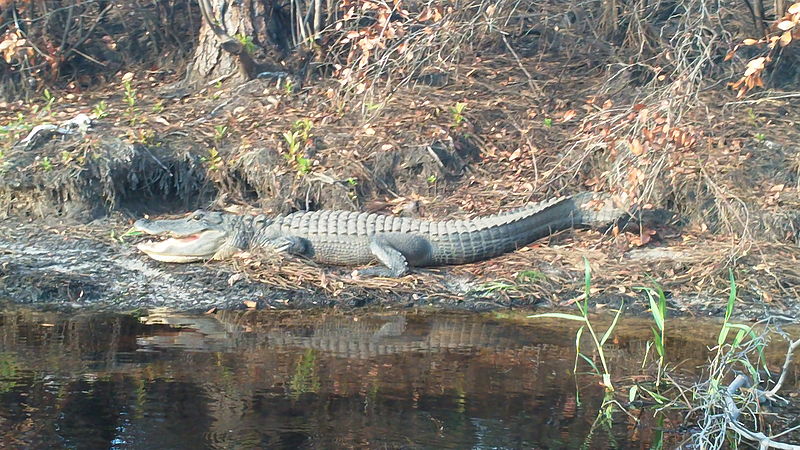 An alligator in Okefenokee National Wildlife Refuge, near Waycross, Georgia (source: U.S. Fish and Wildlife Service).
An alligator in Okefenokee National Wildlife Refuge, near Waycross, Georgia (source: U.S. Fish and Wildlife Service).
In the next report an alligator boy goes to court. The story appeared on the front page, column 3, of the August 16, 1892, issue of the Southwest-Sentinel, a newspaper published in Silver City, New Mexico (source):
Half Boy Half Alligator
The monstrosity is a boy 14 years of age, who not only bears a close resemblance to a saurian, but hisses, bellows and foams at the mouth, just as an alligator does when angry. He can neither talk nor walk, and is an idiot, practically, save for the fact that when hungry he can make known his wants. If it is time for eating or drinking he lets those about him know by groaning and crawling about the floor on his belly.
The boy’s body is almost entirely covered with scales of a delicate texture. His head is long and flat; his eyes are round and beady and blink with a superficial lid or film, like those of a 'gator. His mouth is long and wide and filled with an unusually large number of teeth.
His legs and arms bear a close resemblance to the corresponding members of an alligator, being flat and turned sideways from immense joints. Altogether he is as near a blending of man and reptile as was ever seen. Water he loves, and he seems to know the presence of it by instinct.
A few days ago the creature was taken before the grand jury and examined by the jurors and several physicians. The jury pronounced him harmless and returned him to the care of his mother.
The secret of the deformity is in the history of the mother some time before the birth of the child.
She and her husband then lived in a wild portion of Florida. One day they were crossing a mill-dam together when two enormous bull alligators met in shallow water and began a terrible combat. She was startled, and turned away and shuddered like an aspen. Her husband compelled her to look again. She did and seemed to have her gaze fixed on the monsters, which crushed each other with their wicked jaws, rolled in the contortions of pain, and lashed the water with their tails into bloody foam, until one was killed and the other crawled out on the bank victorious. For days and days afterward the vision of the battle haunted her, even in her dreams, and the dreadful result is the monstrosity she bore.
The next report describes a pair of alligator-human hybrids residing in the swamps of south Georgia (U.S.). It appeared on page 3, column 3, of the November 12, 1896, issue of The Hocking Sentinel, a newspaper published in Logan, Ohio (source). Note the lack of specifics regarding the identity of not only the alleged hybrids but also their parents.
GEORGIA’S ALLIGATOR CHILDREN
They Were Born with Scales and other
Saurian Markings
Down in a far away southern portion of Georgia is an extensive swamp called Grand Bay. It is a branch of the great Okefenokee Swamp. On the borders of this swamp live a pair of freaks the like of which are not to be found elsewhere. They are known as the “alligator children,” and are the offspring of a man and a woman of the poorest class of piney woods “crackers.” [Cracker is a name often used to refer to rural Georgians.]
The eldest of the “alligators” is now twenty-three years of age, and in the best of health, except for her deformity. Shortly before the birth of this child the mother, Mrs. James Dawdy, was frightened by suddenly coming upon a huge alligator. The little girl shortly thereafter born to her was in appearance half human and half reptile.
Her head and face was elongated, her jaws protruded. There was only a very scant growth of hair on her head, and down her back extended a row of dark callousities like the scales on an alligator’s back. She had a well defined tail several inches long, and her fingers and toes bore an unmistakable resemblance to an alligator’s claws. About a year later a second child was born, a boy, and he showed the same peculiar markings, only they were not so strongly defined as those of the girl.
Both children were mutes, and all efforts of the parents to teach them to utter intelligible words were unavailing. The girl made her wants known by a sort of whining sound, and when angry would snarl like an alligator. She was very unruly. The boy was more tractable, but both he and his sister displayed all the characteristics of the alligator.
The girl would be now about five feet high if she could stand upright, but the same number of feet long would be the more appropriate way to describe her longitudinal dimensions. The jaws bear a strong resemblance to those of an alligator, and curving claws, calloused by long use in creeping about the floor, disfigure her hands and feet.
The boy is more docile and exhibits a higher degree of intelligence, and will accept sweetmeats, holding them in his jaws as he crouches in the corner, munching them with evident satisfaction. He, too, creeps on all fours about the house.
The other children of the family are of average intelligence, and show no kinship with their less fortunate brother and sister.
[The article above appeared in various newspapers around the U.S. (for example also here).]
So all and all, the evidence for alligator-human hybrids, though rather copious, over-the-top and entertaining, is really quite iffy. Some eyewitness reports and well-characterized specimens would be nice, please.
|
Two men, Sessions and Thomas, exhibited at Lake City last week a monstrosity of a human shape, in a boy, who, they say, resembles an alligator in form and motion.
—The Weekly Sumter Republican (Aug. 29, 1873)
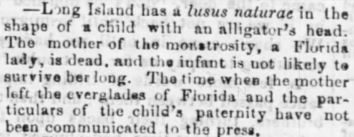 Above: A brief notice about an alligator-human hybrid (Ebensburg, Pennsylvania, Cambria Freeman, Mar. 23, 1872, p. 2, col. 5).
Above: A brief notice about an alligator-human hybrid (Ebensburg, Pennsylvania, Cambria Freeman, Mar. 23, 1872, p. 2, col. 5).
|
According to Ploeg (2013, A Cultural History of Crocodiles in the Philippines, p. 33; ||uplef67)
‡The Moravian naturalist Georg Joseph Kamel (1706, p. 2267) gave an account of what seems to have been this same case.
 Mandelslo
MandelsloThis belief was mentioned, too, by the seventeenth-century German adventurer Johan Albrecht de Mandelslo (1616–1644) in his Voyages and Travels.† The following is an English translation of a passage in a French edition of his book.
†. Full title: The Voyages and Travells of the Ambassadors Sent by Frederick Duke of Holstein, to the Great Duke of Muscovy, and the King of Persia: Begun in the Year M.DC.XXXIII, and Finish'd in M.DC.XXXIX : Containing a Compleat History of Muscovy, Tartary, Persia, and Other Adjacent Countries : with Several Publick Transactions Reaching Near the Present Times.
By the same author: Handbook of Avian Hybrids of the World, Oxford University Press (2006).
Egyptian reverence for the crocodile
a crocodile-human hybrid.
The ancient Egyptians reportedly practiced sexual congress with the crocodile (Masters 1962; Ramsis 1969). During this ritual, which was thought to bring prosperity and increase the potency of the participating male, the female crocodile was turned on her back, which rendered her helpless. Herodotus (The History, Book II, 69) wrote that “The crocodile is esteemed sacred by some of the Egyptians, by others he is treated as an enemy. Those who live near Thebes, and those who dwell around Lake Moeris, regard them with especial veneration. In each of these places they keep one crocodile in particular, who is taught to be tame and tractable. They adorn his ears with ear rings of molten stone [i.e., glass] or gold, and put bracelets on his forepaws giving him daily a set portion of bread, with a certain number of victims, and, after having thus treated him with the greatest possible attention while alive, they embalm him when he dies and bury him in a sacred repository.”